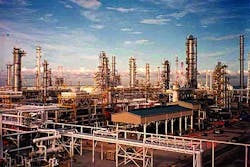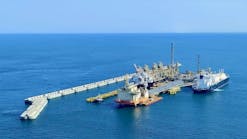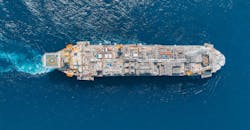Thi Chang
Refining/Petrochemical Editor
PSR-2 is the largest initial-dollar investment ever made by Conoco Inc. in a refining project. The vacuum unit is in the center of the photo, the tall column on the right is the crude tower, and the right-most vessel is the hydrocracker reactor.About this report...In this year's annual Refining Report, Thi Chang, Refining/Petrochemical Editor, focuses on two Asian grassroots refineries, one in Malaysia and the other in Taiwan. Also in this report is coverage of major refinery upgrades in the U.S. and South America.
In August 1998, Malaysia's seventh refinery, called Petronas Second Refinery Phase II (PSR-2), in Melaka, Malaysia, began receiving crude via its crude-distillation unit.
Since then, the company has gradually commissioned other units as it brings its grassroots refinery up to the refinery's 100,000 b/d design crude-distillation capacity.
The refinery is owned by Malaysia Refining Co. Sdn. Bhd., a joint venture consisting of Petronas of Malaysia (45%), Conoco Inc. (40%), and Den norske stats oljeselskap AS (Statoil, 15%).
Companies in Taiwan, India, and the U.A.E. are also commissioning 100,000 b/d+ grassroots refineries before the end of 1999 (OGJ, Oct. 5, 1998, p. 63). Including PSR-1, Petronas' first refinery in Melaka, the complex is the largest refining center in Malaysia. PSR-1 and PSR-2 have as a total crude-distillation capacity of 200,000 b/d.
Fig. 1 [109,177 bytes] shows a simplified flow diagram of the new PSR-2 refinery.
Synergies
PSR-2 was constructed adjacent to the Petronas Second Refinery Phase I (PSR-1), which was commissioned in 1994. PSR-1 is solely owned by Petronas.This early hydroskimming refinery was built to process sweet crudes and condensates, such as that from the offshore fields of Terengganu and Sarawak. PSR-2, on the other hand, was designed to handle sour crudes and is a significantly more complex conversion refinery.
To take advantage of efficiencies, the two refineries will share several facilities, including intermediate and product storage, utilities (excluding electricity), hydrogen-production facilities, the jetty infrastructure, fire-fighting systems, and administration buildings.
PSR-1 sends naphtha and low-sulfur waxy resid (LSWR) to be upgraded in PSR-2.
Additional synergies between the two refineries include a shared maintenance organization as well as shared health, safety, and environmental support systems.
PSR-2's electrical power will be sourced externally, and nitrogen will be supplied by a third party. PSR-2 is connected to the Malaysian natural-gas grid, which supplies the refinery with natural gas, both for fuel and as feed to the hydrogen plant.
Project management
Basic engineering for PSR-2 began in June 1993 by Foster Wheeler International Corp., Clinton, N.J. Detailed engineering, procurement, construction, and commissioning was awarded to a consortium led by Chiyoda Corp., Yokahama, Japan, in January 1995.Table 1 [25,939 bytes] lists, in the order of commissioning date, the new units associated with the refinery.
A strategic decision was made to not experiment with any new technology in this grassroots refinery.
Major units include a 100,000 b/d atmospheric crude-distillation unit, a 62,000 b/d vacuum-distillation unit, a 26,000 b/d catalytic reformer, a 35,000 b/d distillate hydrotreater, and a 21,000 b/d delayed coker.
Conoco licensed its own delayed coking technology to the refinery. Rather than having a catalytic cracking unit, the owners chose to use a hydrocracker to upgrade the heavier vacuum-gas oils to distillates. Although most units had been commissioned by the end of 1998, the 28,500 b/d hydrocracker was started up in 1999. It was the last major unit to begin operations.
PSR-2 has a two-train sulfur-recovery unit (SRU). The unit is capable of producing 200 tons/day of sulfur with a Superclaus-cleanup stage.
The previously mentioned units belong to the first stage of PSR-2's construction. A second stage, which will include a lube-oil hydrocracker and base-oil production, is currently being designed.
During peak construction, about 7,000 workers were involved. More than 40% of the value of the project was carried out by Malaysian companies, including detailed engineering, vessel fabrication, civil work, and piping and general construction.
For start-up of the refinery, about 80 expatriates from the U.S., U.K., India, and Japan were used. With the achievement of stable operations, PSR-1 and PSR-2 require about 750 employees to operate the refinery.
Petronas Penapisan Melaka Sdn. Bhd. (PPMSB), a wholly owned subsidiary of Petronas, is responsible for operating the refinery.
Operators were initially trained using the PSR-1 units. They were then sent to practice at operating units in India, Japan, Norway, and the U.S. For further training on major process units, operators practiced on dynamic simulators, which PSR-2 purchased from Sacda Inc.
According to Gary W. Edwards, Conoco's executive vice-president for worldwide refining, marketing, supply, and transportation, PSR-2 was completed within the original estimate of $1.4 billion, which includes the costs of buy-in to shared facilities.
Feeds, products, market
The refinery is capable of processing 100,000 b/sd of a 70/30 mix of sour/sweet crude as well as LSWR and naphtha products from PSR-1.A large portion of the crude feed can consist of Middle East heavy sour crude oils. The design crude slate is shown in Table 2 [6,338 bytes]. LSWR is approximately 11% of this design mix.
Crude to PSR-2 will be delivered via a single-point mooring (SPM) line or the refinery jetty. The SPM is located 8 km offshore, in the Strait of Malacca. It will transfer crude from very large crude carriers (VLCCs). Smaller tankers with drafts of up to 17 m will use one of two offloading points on the 1.6 km jetty.
Refinery products include LPG, gasoline, kerosine, diesel, fuel oil, asphalt, fuel coke, and sulfur. Approximate proportions are listed in Table 3 [10,483 bytes].
The refinery will provide a strategic and secure source of refined products supply in the Asia/Pacific region for Conoco, which will use its share of the refined products to support its entry into the Malaysian motor fuels retail market. Also, the products will serve Conoco's growing Jet-branded retail operations in Thailand.
"PSR-2 will be the anchor for the regional growth of Conoco's retail motor fuels marketing program," said Edwards.
The refinery is capable of meeting fuel requirements in the Asia/Pacific region as well as the U.S. West Coast, both target markets for the gasoline and diesel products.
Controls and control centers
In PSR-2, basic regulatory controls are implemented through a Honeywell TDC 3000 distributed control system (DCS). Some stand-alone controls are performed through programmable logic controllers (PLCs).Advanced controls, although they will be implemented in the future, were not implemented at this time to allow the operation to become stable. The design of the advanced controls is complete, however, and ready for future use.
PSR-1 and PSR-2 have two main control centers. One control room has consoles for process units and utilities. The offsite units, which consist of storage, blending, and loading, are controlled in the oil movements and storage (OMS) control room.
In addition, there are five satellite-control rooms that house TDC HPM (High-Performance Process Manager) cabinets, other control cabinets, and one operator station. The HPM controller responds to field data by adjusting instrumentation to meet operating parameters.
Air, noise, and water
PSR-2 used the Recommended Malaysia Air Quality Guidelines (Rmaqg) for SO x and NO x emission levels and Department of Energy (DOE) guidelines to design its plant. The Rmaqg limits for ground-level concentrations are:- SO2-350 g/cu m (1 hr), 105 g/cu m (24 hr)
- NO2-320 g/cu m (1 hr).
The refinery is required to submit a quarterly report to the DOE for air quality, stack emissions, noise, effluent discharge, and groundwater quality.
PSR-1 and PSR-2 each has an effluent treatment system (ETS) that is shared between the refineries. The combined capacity of the ETS system is as follows:
- Oily surface water-424 cu m/hr
- Oily water-379 cu m/hr (two sour-water stripper units)
- Ballast water-450 cu m/hr
- Sanitary water-49 cu m/hr.
The new ETS includes four key systems:
- A primary and intermediate effluent treatment system
- A secondary treatment and thickening facility
- A collection system
- A sludge-coking system.
Copyright 1999 Oil & Gas Journal. All Rights Reserved.



